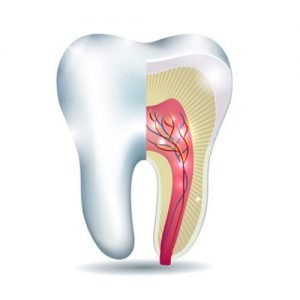Even a tooth severely damaged by decay or injury can sometimes be saved by a root canal procedure, when performed by an experienced and well-trained dentist.
Reasons for a root canal
 The most frequent cause for a root canal is when the pulp of the tooth becomes inflamed or infected. The pulp is the soft tissue in the tooth’s roots, where the blood vessels and nerves reside.
The most frequent cause for a root canal is when the pulp of the tooth becomes inflamed or infected. The pulp is the soft tissue in the tooth’s roots, where the blood vessels and nerves reside.
Common reasons for damaged pulp include when a tooth is severely cracked or chipped, or due to a deep cavity or old leaky filling.
If the damaged or infected pulp is not removed, then the tissue around the root of the tooth will eventually become infected, known as an abscess. If left untreated, bacteria can cause bone loss and eventually tooth loss.
Why should I save my tooth from extraction?
Missing teeth can cause subsequent issues. The remaining teeth may shift, causing an uneven bite. Regular eating and chewing can be more difficult as can performing good daily oral hygiene, which can make a person more vulnerable to other oral health problems such as gum disease.
What happens during a root canal?
At the first visit, after the anesthetic is applied, any bacteria and infected pulp are removed from the tooth using special instruments designed for reaching into the tooth’s canals. The inside of the tooth is thoroughly rinsed and then filled with a rubber-like permanent filling. Removing the tooth’s pulp makes it brittle, which is why the tooth will require a crown to be placed over the tooth at a later appointment.
Root canal technology
State-of-the-art dental practices like Pittsford Smiles Dental have sophisticated monitoring tools that can locate the exact location of bacterial infection and, rather than use traditional drills, ultrasonic tools are now available which remove infected tissue while leaving as much of the healthy tooth structure intact as possible.
How do I know if I need a root canal?
The best way to determine if you need a root canal is to see the dentist for an evaluation but here are common symptoms to look for that may indicate a root canal is in your future:
- Pain when chewing or biting
- Pain or sensitivity to extreme temperatures (specifically cold)
- Visible signs of an infection of the gum area (pimple-like abscess)
- Severe pain that does not subside with over-the-counter medication
- Tenderness or swelling of the gums
- Darkened tooth (grayish in color)
Root Canal Treatment Fairport, Pittsford, and Rochester, NY
If you are experiencing symptoms as listed above, call our Pittsford, NY office today at (585) 248-2575 to schedule a consultation.
Pittsford Smiles Dental serves patients in Fairport, Pittsford, and Rochester, NY.
Don’t forget to share this via Twitter, Google+, Pinterest and LinkedIn.
